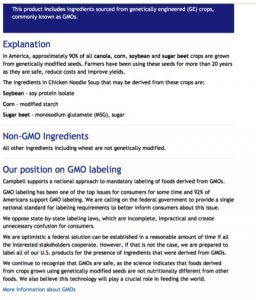
In this space in June 2014, we excitedly shared the news about Vermont’s first-in-the-nation GMO food labeling bill. The law required food producers to indicate on labels if a food was made with genetically engineered ingredients.
Vermont’s law followed several referendum defeats in other states that attempted to require labeling, defeats made possible by the extremely well-funded opposition campaigns waged by pro-GMO business interests. Immediately after passage, Vermont was rewarded with a lawsuit from the Grocery Manufacturers Association (GMA) and other industry allies. The GMA argued that genetically engineered ingredients posed no dangers and would economically disadvantage GMO producers, that it violated interstate commerce protections and would be costly to consumers, and that it couldn’t be complied with due to a shortage of GMO-free ingredients. However, when the GMA’s attempt to prevent the law’s implementation was blocked by a federal court in 2015, companies began to turn around, announcing that they would label their GMO-containing items not just for products intended for sale in Vermont, but nationwide. It wasn’t that hard to label after all, which shouldn’t have been too surprising considering that 64 nations around the world already require it.
It Depends on What Your Definition of “Label” Is

But Big Grocery didn’t stop fighting the law. It urged Congress to take action to create one uniform bill rather than a patchwork of state laws. This might sound like a reasonable approach to policymaking — unless the intention is to strip out the statute’s raison d’etre. In July 2016, this was accomplished when federal legislation signed by President Obama nullified the Vermont bill and gutted its centerpiece, the requirement that if a product was produced with genetic engineering, its package should clearly say so. Instead, Senate Bill 764 amends the Agricultural Marketing Act of 1946 to allow food producers to use a symbol, 800 number, or a QR code to provide the information. A QR code is the Rohrschach test-resembling symbol at right that must be read by a scanning application, which means it is currently useless to shoppers not in possession of a smartphone, a good cell or Wi-Fi signal, or the kind of forbearance that can be hard to summon in a supermarket, even under the best of circumstances. The Just Label It campaign took amusing aim at this scheme in a pointed video (complete with a cameo by Gwyneth Paltrow) depicting a harried mother’s doomed attempt to scan a package quickly before her children can unleash havoc in the aisles.
It’s a weak bill in other ways. It does not grant the U.S. Department of Agriculture authority to require recalls of noncompliant products, and it imposes no federal penalties for violations. States can impose fines under their own consumer protection rules.
The congressional compromise has led to allegations of betrayal within the organic food movement, with some accusing the corporate members of the Organic Trade Association of standing by while the bill’s sponsors pulled a fast one. It is certainly an outrage to lose this round to compromising politicians and the industry that finances them when consistent majorities of Americans have expressed their desire for GMO labeling, and when sales of natural, organic, and non-GMO food companies are growing at about three times the rate of their conventional counterparts.
However, while QR codes and 800 numbers indisputably make GMO information less transparent and accessible in the near term, within a few years, the food shopping experience will undergo a dramatic transformation that might — might —satisfy both producers and labeling advocates.

With the assistance of the GMA’s planned “smart labels” and in-store kiosks that can read them, consumers will have a wealth of information about food and other products available to them. The kiosk business is booming, offering a wide range of services beyond label scanning, including recipe hunting, loyalty card information, wine pairing, converting unwanted gold jewelry into cash (we’re not making that up), and checking one’s blood pressure. With such potential within reach, we could be looking at a future where not only is GMO status readily available to shoppers, but also characteristics of arguably equal importance to sustainability (argues Grist’s Nathanael Johnson) such as pesticide and water use, greenhouse gas emissions associated with the product, food worker wages, and more.
But while smart labels and kiosks proliferate, will they be read by hurried shoppers? It’s easy to forget how huge the digital divide in this country remains. In a letter to President Obama, Reverend Jesse Jackson wrote,
The GMO labeling law’s principal thrust is to rely on QR codes which shoppers will scan to gain product information relative to GMOs. However, 100,000,000 Americans, most of them poor, people of color and elderly, either do not own a smartphone or an iPhone to scan the QR code or live in an area of poor Internet connectivity. There are serious questions of discrimination presented here and unresolved matters of equal protection of the law.
And as TriplePundit.org noted in “How a Bad GMO Bill Becomes Law”:
While it may be assumed that many low-income families live in metropolitan areas, the fact is, most live in rural areas, where Internet coverage is often less available. According to the USDA’s own statistics, 18.1 percent of low-income families lived in rural areas in 2014, while 15.1 percent lived in cities.
The saving grace of S. 764 is its requirement that the secretary of agriculture conduct a study within two years to identify factors that would challenge consumer access to the electronic or digital disclosure methods, such as the availability of an internet signal or cell network, the availability of a landline in stores, and challenges facing small and rural retailers in providing internet access. If the study determines that consumers would not have sufficient access to information, the secretary “shall provide additional and comparable options to access the bioengineering disclosure.”
As always … stay tuned.
